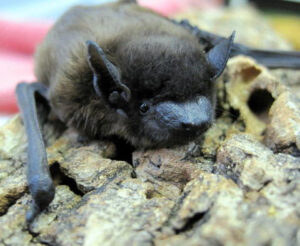Evening Bat
Scientific Name: Nycticeius humeralis
Description.
The evening bat is a smaller bat that ranges from 86 to 105mm in length. These bats tend to weigh from 6 to 14 grams, and their wingspan ranges from 260 to 280mm. The evening bat is dark brown, except for its black ears. This species may be confused with Myotis species, though the curved tragus of the evening bat can differentiate the two genera. These bats are more often confused with the big brown bats (Eptesicus fuscus). Big brown bats are larger and lack a keel on the calcar.
Distribution.
The evening bat ranges from Southern Ontario, along the eastern United States, to northeastern Mexico.
Ecology and Behavior.
This species usually inhabits buildings or tree cavities in summer. These bats are almost never found in caves. Evening bats are social, and are found in roosting colonies of about 30 individuals. While their winter habitat is unknown, they do migrate south during the colder months. Females in northern populations migrate south, but the males do not follow females to their northern maternity colonies in the spring.
Food and Feeding.
Evening bats feed on flies, moths, leafhoppers, and beetles that they catch in midair during their slow, steady flight. A colony of 100 bats can consume over 1.25 million insects a season.
Reproduction and Development.
Mating takes place in the late summer and early fall, but the females store the sperm until spring. One male can mate with up to 20 females. Females often give birth to twins (or in some cases triplets), and the young are born in nursery colonies located in hollow trees, attics, buildings, and behind loose bark. The young are pink and hairless when they are born. They learn to fly at around three weeks, and male pups leave the roost after six weeks. The female pups stay in the colony.
Status.
Uncommon through most of its range, but one of the most common bats throughout the southern coastal states.
- Click here to see where you can find the Evening Bat in NC!

